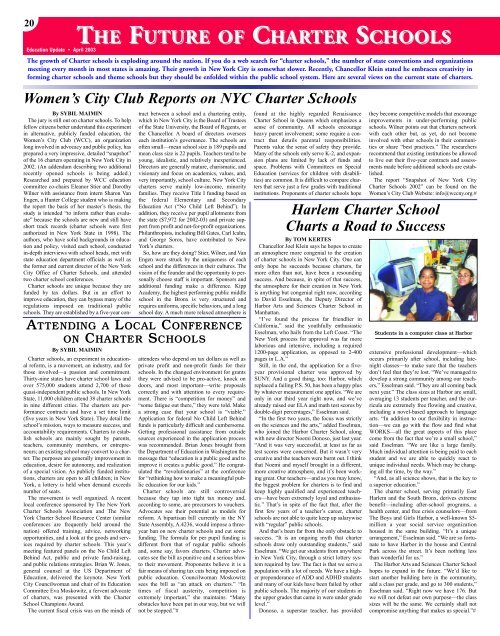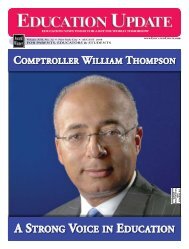Download PDF - Education Update
Download PDF - Education Update
Download PDF - Education Update
You also want an ePaper? Increase the reach of your titles
YUMPU automatically turns print PDFs into web optimized ePapers that Google loves.
20<strong>Education</strong> <strong>Update</strong> • April 2003THEFUTUREUTURE OF CHARTERSCHOOLSCHOOLSThe growth of Charter schools is exploding around the nation. If you do a web search for “charter schools,” the number of state conventions and organizationsmeeting every month in most states is amazing. Their growth in New York City is somewhat slower. Recently, Chancellor Klein stated he embraces creativity informing charter schools and theme schools but they should be enfolded within the public school system. Here are several views on the current state of charters.Women’s City Club Reports on NYC Charter SchoolsBy SYBIL MAIMINThe jury is still out on charter schools. To helpfellow citizens better understand this experimentin alternative, publicly funded education, theWomen’s City Club (WCC), an organizationlong involved in advocacy and public policy, hasprepared a very impressive, detailed “snapshot”of the 16 charters operating in New York City in2002. (An addendum describing two additionalrecently opened schools is being added.)Researched and prepared by WCC educationcommittee co-chairs Eleanor Stier and DorothyWilner with assistance from intern Sharon VanEngen, a Hunter College student who is makingthe report the basis of her master’s thesis, thestudy is intended “to inform rather than evaluate”because the schools are new and still haveshort track records (charter schools were firstauthorized in New York State in 1998). Theauthors, who have solid backgrounds in educationand policy, visited each school, conductedin-depth interviews with school heads, met withstate education department officials as well asthe former and current director of the New YorkCity Office of Charter Schools, and attendedtwo charter school conferences.Charter schools are unique because they arefunded by tax dollars. But in an effort toimprove education, they can bypass many of theregulations imposed on traditional publicschools. They are established by a five-year contractbetween a school and a chartering entity,which in New York City is the Board of Trusteesof the State University, the Board of Regents, orthe Chancellor. A board of directors overseeseach institution’s governance. The schools areoften small—mean school size is 189 pupils andmean class size is 22 pupils. Teachers tend to beyoung, idealistic, and relatively inexperienced.Directors are generally mature, charismatic, andvisionary and focus on academics, values, and,very importantly, school culture. New York Citycharters serve mainly low-income, minorityfamilies. They receive Title I funding based onthe federal Elementary and Secondary<strong>Education</strong> Act (“No Child Left Behind”). Inaddition, they receive per pupil allotments fromthe state ($7,972 for 2002-03) and private supportfrom profit and not-for-profit organizations.Philanthropists, including Bill Gates, Carl Icahn,and George Soros, have contributed to NewYork’s charters.So, how are they doing? Stier, Wilner, and VanEngen were struck by the uniqueness of eachschool and the differences in their cultures. Thevision of the founder and the opportunity to personallychoose staff is important. Sponsors andadditional funding make a difference. KippAcademy, the highest performing public middleschool in the Bronx is very structured andrequires uniforms, specific behaviors, and a longschool day. A much more relaxed atmosphere isATTENDING A LOCAL CONFERENCEON CHARTER SCHOOLSBy SYBIL MAIMINCharter schools, an experiment in educationalreform, is a movement, an industry, and forthose involved—a passion and commitment.Thirty-nine states have charter school laws andover 575,000 students attend 2,700 of thesequasi-independent public schools. In New YorkState, 11,000 children attend 38 charter schoolsin nine different cities. The charters are performancecontracts and have a set time limit(five years in New York State). They detail theschool’s mission, ways to measure success, andaccountability requirements. Charters to establishschools are mainly sought by parents,teachers, community members, or entrepreneurs;an existing school may convert to a charter.The purposes are generally improvement ineducation, desire for autonomy, and realizationof a special vision. As publicly funded institutions,charters are open to all children; in NewYork, a lottery is held when demand exceedsnumber of seats.The movement is well organized. A recentlocal conference sponsored by The New YorkCharter Schools Association and The NewYork Charter School Resource Center (similarconferences are frequently held around thenation) offered training, advice, networkingopportunities, and a look at the goods and servicesrequired by charter schools. This year’smeeting featured panels on the No Child LeftBehind Act, public and private fund-raising,and public relations strategies. Brian W. Jones,general counsel at the US Department of<strong>Education</strong>, delivered the keynote. New YorkCity Councilwoman and chair of its <strong>Education</strong>Committee Eva Moskowitz, a fervent advocateof charters, was presented with the CharterSchool Champions Award.The current fiscal crisis was on the minds ofattendees who depend on tax dollars as well asprivate profit and non-profit funds for theirschools. In the changed environment for grantsthey were advised to be pro-active, knock ondoors, and most important—write proposalscorrectly and with attention to every requirement.There is “competition for money” and“some fatigue out there,” they were told. Makea strong case that your school is “viable.”Application for federal No Child Left Behindfunds is particularly difficult and cumbersome.Getting professional assistance from outsidesources experienced in the application processwas recommended. Brian Jones brought fromthe Department of <strong>Education</strong> in Washington themessage that “education is a public good and toimprove it creates a public good.” He congratulatedthe “revolutionaries” at the conferencefor “rethinking how to make a meaningful publiceducation for our kids.”Charter schools are still controversialbecause they tap into tight tax money and,according to some, are precursors to vouchers.Advocates see their potential as models forreform. A bipartisan bill currently in the NYState Assembly, A.4236, would impose a threeyearban on new charter schools and cut somefunding. The formula for per pupil funding isdifferent from that of regular public schoolsand, some say, favors charters. Charter advocatessee the bill as punitive and a serious blowto their movement. Proponents believe it is afair means of sharing tax cuts being imposed onpublic education. Councilwoman Moskowitzsees the bill as “an attack on charters.” “Intimes of fiscal austerity, competition isextremely important,” she maintains. “Manyobstacles have been put in our way, but we willnot be stopped.”#found at the highly regarded RenaissanceCharter School in Queens which emphasizes asense of community. All schools encourageheavy parent involvement; some require a contractthat details parental responsibilities.Parents value the sense of safety they provide.Many of the schools only serve K-2, and expansionplans are limited by lack of funds andspace. Problems with Committees on Special<strong>Education</strong> (services for children with disabilities)are common. It is difficult to compare chartersthat serve just a few grades with traditionalinstitutions. Proponents of charter schools hopethey become competitive models that encourageimprovements in under-performing publicschools. Wilner points out that charters networkwith each other but, as yet, do not becomeinvolved with other schools in their communitiesor share “best practices.” The researchersrecommend that existing institutions be allowedto live out their five-year contracts and assessmentsmade before additional schools are established.The report “Snapshot of New York CityCharter Schools 2002” can be found on theWomen’s City Club Website: info@wccny.org.#Harlem Charter SchoolCharts a Road to SuccessBy TOM KERTESChancellor Joel Klein says he hopes to createan atmosphere more congenial to the creationof charter schools in New York City. One canonly hope he succeeds because charters, farmore often than not, have been a resoundingsuccess. And because, in spite of that success,the atmosphere for their creation in New Yorkis anything but congenial right now, accordingto David Esselman, the Deputy Director ofHarbor Arts and Sciences Charter School inManhattan.“I’ve found the process far friendlier inCalifornia,” said the youthfully enthusiasticEsselman, who hails from the Left Coast. “TheNew York process for approval was far morelaborious and intensive, including a required1200-page application, as opposed to 2-400pages in L.A.”Still, in the end, the application for a fiveyearprovisional charter was approved bySUNY. And a good thing, too: Harbor, whichreplaced a failing P.S. 50, has been a happy plusby whatever measurement one applies. “We areonly in our third year right now, and we’vealready raised our ELA and math test scores bydouble-digit percentages,” Esselman said.“In the first two years, the focus was strictlyon the sciences and the arts,” added Esselman,who joined the Harbor Charter School, alongwith new director Noemi Donoso, just last year.“And it was very successful, at least as far astest scores were concerned. But it wasn’t verycreative and the teachers were burnt out. I thinkthat Noemi and myself brought in a different,more creative atmosphere, and it’s been workinggreat. Our teachers—and as you may know,the biggest problem for charters is to find andkeep highly qualified and experienced teachers—havebeen extremely loyal and enthusiastic.”That’s in spite of the fact that, after thefirst few years of a teacher’s career, charterschools are not able to quite keep up salarywisewith “regular” public schools.And that’s been far from the only obstacle tosuccess. “It is an ongoing myth that charterschools draw only outstanding students,” saidEsselman. “We get our students from anywherein New York City, through a strict lottery systemrequired by law. The fact is that we serve apopulation with a lot of needs. We have a higherpreponderance of ADD and ADHD studentsand many of our kids have been failed by otherpublic schools. The majority of our students inthe upper grades that came in were under gradelevel.”Donoso, a superstar teacher, has providedStudents in a computer class at Harborextensive professional development—whichoccurs primarily after school, including latenightclasses—to make sure that the teachersdon’t feel that they’re lost. “We’ve managed todevelop a strong community among our teachers,”Esselman said. “They are all coming backnext year.” The class sizes at Harbor are small,averaging 13 students per teacher, and the curriculaare extremely free flowing and creative,including a novel-based approach to languagearts. “In addition to our flexibility in instruction—wecan go with the flow and find whatWORKS—all the great aspects of this placecome from the fact that we’re a small school,”said Esselman. “We are like a large family.Much individual attention is being paid to eachstudent and we are able to quickly react tounique individual needs. Which may be changingall the time, by the way.”“And, as all science shows, that is the key toa superior education.”The charter school, serving primarily EastHarlem and the South Bronx, derives extremebenefit—including after-school programs, ahealth center, and free crisis counselors—fromThe Boys and Girls Harbor, a well-known $5-million a year social service organizationhoused in the same building. “It’s a uniquearrangement,” Esselman said. “We are so fortunateto have Harbor in the house and CentralPark across the street. It’s been nothing lessthan wonderful for us.”The Harbor Arts and Sciences Charter Schoolhopes to expand in the future. “We’d like tostart another building here in the community,add a class per grade, and go to 300 students,”Esselman said. “Right now we have 176. Butwe will not defeat our own purpose—the classsizes will be the same. We certainly shall notcompromise anything that makes us special.”#
















